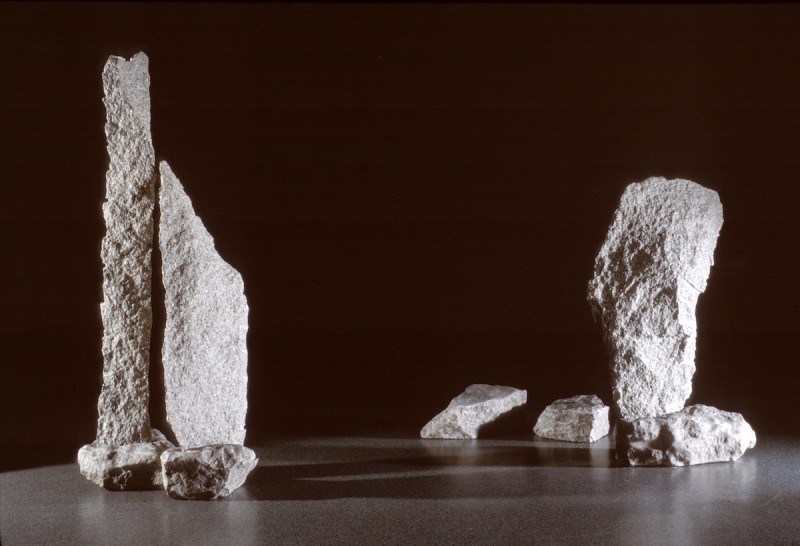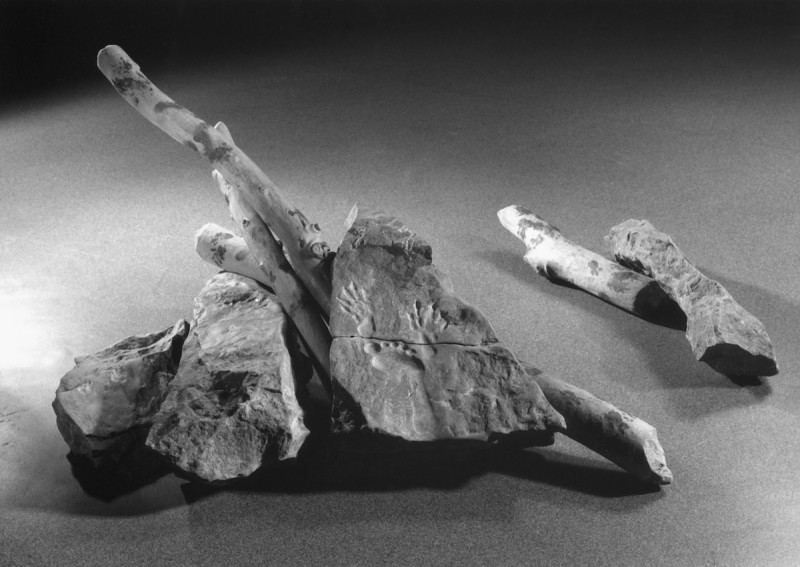
Ordinarily appreciated for its durability stone is perceived as permanent, solid and stable. By way of contrast, Marie Hélène Allain’s work over the past decade bas concentrated on another aspect of stone ‑ its susceptibility to change. Recent sculptures are the result of her ongoing investigation of the process of genesis, growth, decay and regeneration. like this natural cycle, Allains work continues to grow and develop. Over the course of her career there bas been a logical progression in Allain’s work as Carolle Gagnon outlined in her 1994 monograph, Marie Hélène Allain: la symbolique de la pierre. Early serene monoliths exploring the fundamental qualities of stone gave way to knotted, struggling forms seeking definition. These eventually progressed into symbolic assemblages where stone is united with natural and man‑made elements in a new and evocative dialogue. Sculptures from the immediate past have sought the direct interaction of the viewer for an added layer of meaning and pertinence.
Allain’s central inspiration has always been stone. This material both suggests and provides the meaning for the sculptures. While stone still retains its primary importance, in more recent works new materials and iconography are integrated to tell more elaborate stories or to share ideas. On the carefully arranged granite columns and limestone blocks of Spectres de la baleine / Spectres of the Whale (1998), the mysterious, yet precise and geometric, channels that penetrate the surface indicate the vestigial, but permanent, traces of previous experiences. The fourteen unwrought shards of Paradoxe / Paradox (1998), take flight in a graceful arc as they escape from the violence forced upon an assaulted, scarred and fractured mass. The expectant attendants of Apprendre / To Learn (1999) congregate patiently around the pedestal of an idolized sentinel in some enigmatic ritual. Like a fossilized specimen excavated and transported in its entirety from a pristine natural environment, the limestone slabs of Co‑op limitée / Limited Co‑op (2000) document the presence of animals and humans in some interrupted and industrious activity. The very essence of the stone itself is challenged in the wry and whimsical representation of identity and hospitality in Présente / Here (2000). The impression of primeval ceremony in Autel d’offrandes / Offerings’ Altar (2001) implies the transformations inherent in the fusion of personal spiritual realization in its intricate rearrangement of eroded sandstone, pebbles and corroded iron. In all these sculptures, by not subjugating the materials to the idea but rather by intuitively melding the incidental and the deliberate, Allain’s sensitive empathy reveals their latent identities and allows them to speak for themselves.

I have become intimately acquainted with a great number of Marie Hélène Allain’s sculptures completed since 1993. In the coordination of the exhibition, Une pierre pour toi / A Stone for You, more than twenty individual sculptures needed to be viewed, transported, photographed and installed (sometimes more than once). Contemplating how each work could be seen to advantage and how they worked together in a grouping was made easier and infinitely more enjoyable by collaborating with the artist who was closely involved and contributing to the entire process. Having the creator of the works share or explain the particular story of each piece provided both insight and context; unfortunately, this is a luxury not enjoyed by everyone who encounters one of the works. What can be appreciated universally, however, is Allain’s consistent and remarkable ability to create and accept the fragile balance between the accidentally found and the intentionally fabricated. Allain masterfully synthesizes this complex dichotomy. With unerring sensitivity she formulates a sophisticated discourse between the formal principles of sculpture and the lyrical qualities of personal vision.
Peter J. Larocque
Curator of New Brunswick Cultural History and Art
New Brunswick Museum
Published in 2004
Text reproduced by kind permission of the author